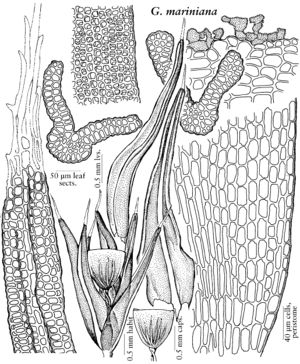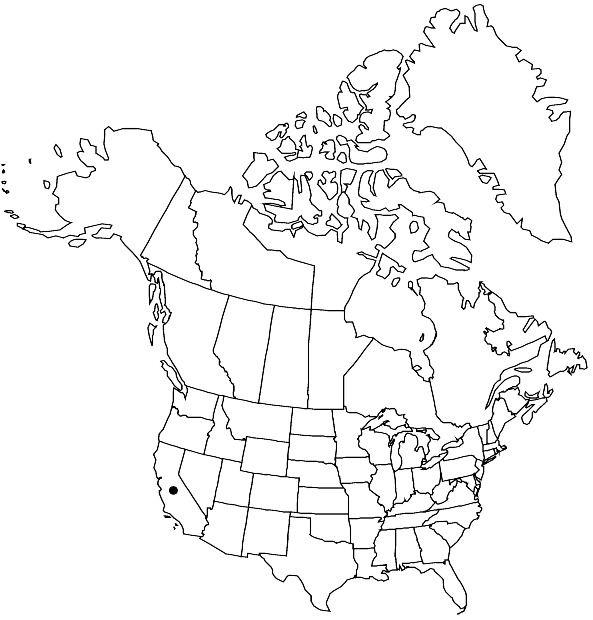Grimmia mariniana
Bryologist 58: 323. 1955,.
Plants in hoary loose cushions, emerald green to black. Stems 0.6–1.2 cm, central strand weak. Leaves linear-lanceolate to narrowly ovatelanceolate, 1.5–2.1 × 0.5–0.7 mm, keeled, not plicate, margins incurved distally, awn 0.4–0.8 mm, costal transverse-section prominent, semicircular; basal juxtacostal laminal cells short-rectangular to elongate, sinuose, thick-walled; basal marginal laminal cells quadrate to short-rectangular, straight, thick-walled, hyaline; medial laminal cells quadrate, sinuose, thick-walled; distal laminal cells 2-stratose, not bulging, marginal cells 2-stratose, not bulging. Sexual condition dioicous, perichaetial leaves slightly enlarged. Seta straight, to 1 mm. Capsule occasionally present, immersed to emergent, yellow (rarely brown), ovoid with an open mouth, faintly but distinctly ribbed, exothecial cells rectangular, thick-walled, stomata absent, annulus of 1 row of quadrate, thick-walled cells, operculum rostellate, with a short obtuse beak, peristome present, but rudimentary, teeth composed of only a few basal-cells, sometimes perforated.
Habitat: Acidic sedimentary and basaltic metavolcanics
Elevation: moderate elevations 900-1200 m
Discussion
Of conservation concern.
Grimmia mariniana is known only from the coastal mountains of central California. If fertile, the immersed capsules with rudimentary peristome teeth will separate it from both G. montana and G. alpestris, which, while also being dioicous and without stomata, have long-exserted capsules with fully-developed peristome teeth. Grimmia nevadensis is similar but lacks peristome teeth, has uniformly rectangular, thin-walled basal laminal cells, and does not have hyaline margins. The faint ribs on the capsules of G. mariniana may not be evident when the capsules are not turgid. Sterile specimens can be separated from G. alpestris by the lack of bulging cells, and the narrow leaves. Distinguishing sterile specimens of G. mariniana from G. montana is more problematic, as both have narrowly ovate-lanceolate leaves, with similar areolation. However, the basal marginal laminal cells of G. mariniana are hyaline while those of G. montana are not. Grimmia mariniana is easily separated from G. arizonae and G. pilifera, two other members of the subgenus, along with G. nevadensis, that have immersed capsules. Sporophytically, both G. arizonae and G. pilifera have abundant stomata, well-developed peristome teeth, and rectangular, thick-walled, multi-layered annuli. Gametophytically, the incurved leaf margins of G. mariniana contrast sharply with the recurved leaf margins of G. arizonae and G. pilifera. Sayre noted the similarity of G. mariniana to G. anodon. The straight, centrally attached seta and symmetric capsule usually with rudimentary peristome teeth will serve to separate specimens of G. mariniana from G. anodon. Gametophytically, the long, narrow leaves, with incurved margins and 2-stratose distal laminal cells separates G. mariniana from G. anodon.
Selected References
None.

